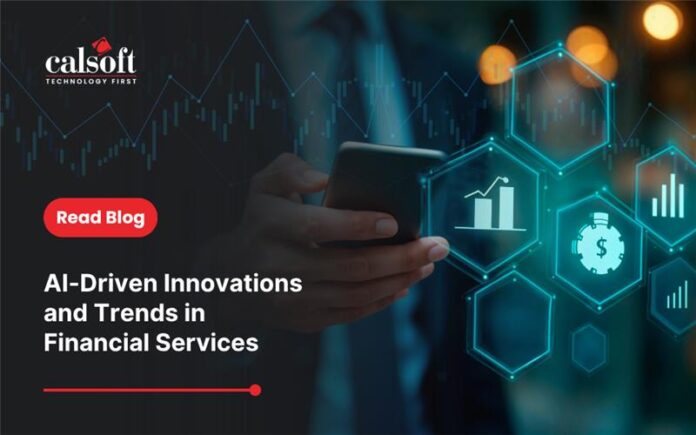Artificial Intelligence (AI) is no longer just a buzzword; it’s at the core of how modern financial institutions operate. In just a few years, the financial sector has moved from using basic chatbots and experimenting with data models to using AI across critical areas. From customer experience to fraud detection and regulatory compliance, AI has proven to be a necessity for financial institutions navigating the new landscape.
With AI at the forefront, the financial sector is taking on the market head-on by fostering innovative ways to meet customer demands.
In this blog, we will explore some of the most impactful trends we are seeing in 2025 and how Calsoft is helping clients stay ahead of the game.
AI Trends in the Financial Sector
To enhance the operations and performance of the financial sector, AI-assisted innovations and solutions play a vital role. Some of the key AI-driven innovations are listed below.
Generative AI is Evolving: Chatbots/Virtual Assistants
Generative AI (Gen AI) is no longer just an experiment. What once began as curiosity has now become essential to providing the best customer experience. Gen AI now powers everything from real-time policy summaries to hyper-personalized financial advice—making customer engagement smarter and more scalable. This is a big change from the days of simple chatbots. AI assistants today are capable of understanding nuance, customer intent, and context in a manner that improves service quality and reduces workload for teams.
However, there is a caveat. Financial institutions need to ensure their Gen AI solutions are secure and compliant with data privacy laws as they deal with sensitive personal and financial data. Read our latest blog on Gen AI Trends in 2025
Real-Time Risk Management and Fraud Prevention
As criminal tactics evolve at an alarming rate, so must the technology used to stop them keep up. Traditional fraud detection systems that rely on fixed rules are unable to handle dynamic attack patterns and small shifts in actions. Current machine learning models can detect anomalies in real time, picking up on suspicious activities before the transactions are completed. Apart from fraud, AI is helping approve credit by analyzing more data sources and including transactional history. This is important in markets where people don’t have detailed credit scores.
While scalable infrastructure, data pipelines, and monitoring the models are important, the priority has shifted to ensuring the ML models aren’t just smart but at the same time can respond instantly and are dependable and safe.
Open Finance Regulation Changes
Open finance is now being enforced worldwide. With systems such as Payment Services Directive 3 in Europe, India’s Account Aggregator setup, and Australia’s Consumer Data Right, banks are under increasing pressure to enable data security measures. This is a good thing for customers, as they benefit from a consolidated financial view and receive offers tailor-made for them. Banking institutions, on the other hand, need to build systems that work together using API platforms that integrate securely with partner ecosystems.
While it may seem challenging from a compliance point of view, open finance opens doors to new ideas, facilitating personalized products to end customers and possibilities for new revenue streams.
Also Read: Understanding IoT Cloud Security and Bes… – Calsoft Blog
Intelligent Process Automation
Intelligent Process Automation (IPA) combines AI, ML and Natural Language Processing (NLP) to automate tasks and entire processes like underwriting, onboarding, and claims checks. For instance, AI can quickly sort and categorize paperwork, while decision tools guide applications using changeable logic with built-in learning. It’s no longer limited to just automating but redesigning how things are done. This means finding key processes, integrating IPA to core systems and creating feedback loops to keep improving.
AI Regulation and Governance
2025 marks a turning point in AI regulation. By classifying systems according to risk categories and mandating explainability for high-impact use cases like lending and insurance, the European Union’s AI legislation is establishing worldwide standards. While US regulators are releasing recommendations on fairness in automated credit determinations and investment strategies, India’s DPDP Act has strengthened the enforcement of data privacy laws. Building trust is more important at this stage. Model documentation, bias testing, audit logs, and unambiguous escalation routes are becoming required components of governance frameworks. Institutions are being urged to demonstrate not only the output of AI but also the process by which judgments are made.
AI in Wealth Management and Trading
Wealth management is transforming because of online investors. Smart, real-time, and highly personalized platforms are what Gen Z and millennial customers demand. Everything from portfolio creation to traders’ real-time news analysis is powered by AI. Automation facilitates tax loss harvesting, portfolio rebalancing, and goal tracking to cater to life events. Great platforms differentiate themselves by their action and insights. This requires good availability, quick response times, data security, and a user experience that people trust.
The use of AI is no longer experimental in these areas: operations, fraud, customer experience, and regulation. It is vital. Institutions that approach AI with the right strategy on ethical design, governance, and user experience in addition to technological implementation will emerge victorious. Multidisciplinary teams, contemporary data platforms, and a readiness to reconsider long-held beliefs are necessary for this change.
Calsoft offerings include cloud-native infrastructure, data engineering, intelligent automation, Gen AI integration, and compliance. Whether you are starting a brand-new AI project or expanding an existing one, we focus on the results that count. Get more insights from one of our engagements: ServiceNow Plugin to Cater to Finance Workflows
| Focus Area | What We Deliver | Client Impact |
| Gen AI & NLP | Custom LLMs, Intelligent assistants, Secure RAG workflows | Personalized engagement, Reduced manual workloads |
| Data & Open Finance | Real-time data platforms, API orchestration, consent systems | Interoperability and revenue from ecosystem partnerships |
| Automation & MLOps | End-to-end automation, model pipelines, monitoring | Operational efficiency, agility and audit readiness |
| AI Governance & Risk | Model traceability, explainability tools, compliance reporting | Regulator confidence and customer trust |
| Cloud-Native Architecture | Kubernetes, serverless deployments, hybrid setups | Scalable, future-proof infrastructure |
Final Thoughts
“Should we adopt AI?” is no longer the question; rather, “How do we do it right?” Building intelligent tools responsibly, on a large scale, and in ways that provide long-term value is key to success. A strategic AI foundation is essential whether you’re working on real-time fraud detection, developing Gen AI use cases, or getting ready for open finance compliance.
FAQ’s
Q1: How is Generative AI different from traditional AI in financial services?
A. Traditional AI models in finance typically rely on predefined rules or narrow tasks, such as flagging fraud or scoring credit. Generative AI, on the other hand, creates content or responses—such as summarizing policy documents, crafting financial advice, or assisting in natural conversation—making it more customer-facing and context-aware.
Q2: What are the key challenges of deploying AI in regulated financial environments?
A. The biggest hurdles include data privacy, explainability, compliance with evolving regulations (like the EU AI Act or India’s DPDP), and ensuring that AI decisions are fair and auditable. A robust governance framework and strong infrastructure are essential.
Q3: Can AI help financial firms serve underbanked or credit-thin populations?
A. Yes. AI models can analyze non-traditional data like payment behavior, mobile usage, or transactional patterns to assess creditworthiness. This is especially valuable in markets with limited access to formal credit history, enabling more inclusive financial services.


